Perhaps the gardens are the best and most reliable indicators of the impending change of season. About a week ago, the plants in the school gardens began to wither and die. 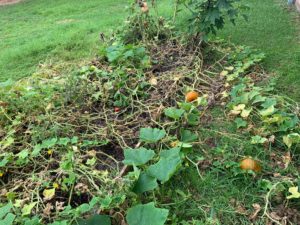 This really surprised me because two weeks before, I had just collected a large harvest (24 pounds, to be exact). But, as a more experienced gardener told me, “It’s fall. The gardens know.” Sure enough, in the days that followed, I noticed that the leaves on the plants that were once vibrant green began to change to hues of yellow and orange. The rate of collection of vegetables decreased dramatically. What was once a thriving, green, lush thicket of vines and leaves, now more closely resembles a field of yellow and brown stems scattered with pumpkins and late season squash. While production in the garden is ceasing, the work of enjoying the vegetables from a busy summer is just beginning. Throughout, the summer, I’ve harvested vegetables from the school gardens, as did many farmers throughout North Carolina and all around the rest of the northern hemisphere.
This really surprised me because two weeks before, I had just collected a large harvest (24 pounds, to be exact). But, as a more experienced gardener told me, “It’s fall. The gardens know.” Sure enough, in the days that followed, I noticed that the leaves on the plants that were once vibrant green began to change to hues of yellow and orange. The rate of collection of vegetables decreased dramatically. What was once a thriving, green, lush thicket of vines and leaves, now more closely resembles a field of yellow and brown stems scattered with pumpkins and late season squash. While production in the garden is ceasing, the work of enjoying the vegetables from a busy summer is just beginning. Throughout, the summer, I’ve harvested vegetables from the school gardens, as did many farmers throughout North Carolina and all around the rest of the northern hemisphere.
In early June, I remember harvesting the first 3 vegetables of the season.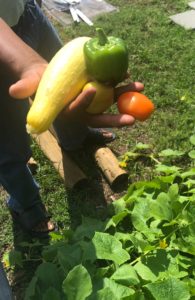 Then, another harvest of 14 pounds came a little later during the summer.
Then, another harvest of 14 pounds came a little later during the summer. After that, another harvest of 19 pounds was collected. Finally, the largest harvest of nearly 25 pounds came at the end of July.
After that, another harvest of 19 pounds was collected. Finally, the largest harvest of nearly 25 pounds came at the end of July. 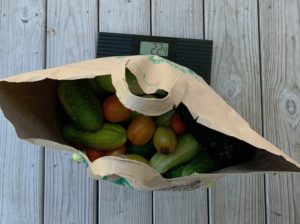 Just like Zora, in, “Zora’s Garden”, I could not keep up. I was giving away vegetables, eating vegetables, and just surrounded by vegetables. Now that the harvests are ending, I, like other agriculture professionals whose growing seasons are also coming to an end, can breathe a sigh of relief, gather ourselves and pat ourselves on the back for all the wonderful work put in this summer.
Just like Zora, in, “Zora’s Garden”, I could not keep up. I was giving away vegetables, eating vegetables, and just surrounded by vegetables. Now that the harvests are ending, I, like other agriculture professionals whose growing seasons are also coming to an end, can breathe a sigh of relief, gather ourselves and pat ourselves on the back for all the wonderful work put in this summer.
This season-ending harvest and impending period of rest has been occurring for millennia. This is the genesis of the fall festivals that we know and enjoy today. The various state fairs, Oktoberfest, La Tomatina, and Thanksgiving have all spawn from the tradition of celebrating, relaxing, and enjoying the “fruits of the summer labor.” While, every culture celebrates a little differently and combines it with their own traditional foods and music, the idea is the same: Gather with family and friends, relax, and enjoy the bounty collected during the summer.
Various State Fairs
These usually occur during late August through the month of October. 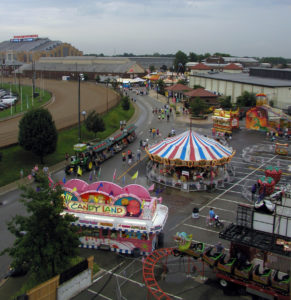 At state fairs, you can find a bounty of freshly picked edibles from the farm, along with carnival style rides and games. In addition, there are traditions, such as hog-calling and hay rides that are associated with each local culture.
At state fairs, you can find a bounty of freshly picked edibles from the farm, along with carnival style rides and games. In addition, there are traditions, such as hog-calling and hay rides that are associated with each local culture.
La Tomatina
In only what can be described as a huge public “tomato food fight”, La tomatina occurs during the last week of August in Valencia, Spain. I can only imagine that this originated from an over-abundance of tomatoes grown during the summer months and as way to relax and relieve the stress of working in the fields.
I can only imagine that this originated from an over-abundance of tomatoes grown during the summer months and as way to relax and relieve the stress of working in the fields.  Today, La Tomatina is combined with the music and games of the Valencian regional culture of Spain.
Today, La Tomatina is combined with the music and games of the Valencian regional culture of Spain.
Diwali
 Diwali is an Indian harvest festival celebrated over five days every year in early autumn after the conclusion of the summer harvest and coincides with the new moon, known as the amāsvasya – the darkest night of the Hindu calendar.
Diwali is an Indian harvest festival celebrated over five days every year in early autumn after the conclusion of the summer harvest and coincides with the new moon, known as the amāsvasya – the darkest night of the Hindu calendar. 
Diwali originated as a festival that marked the last harvest before winter when India was largely an agricultural society where people would seek the divine blessing of Lakshmi, the goddess of wealth, as they closed their accounting books and prayed for success in the new financial year. Today, this practice extends to businesses all over the Indian subcontinent, which mark the fourth day of Diwali as the first day of the new financial year.
Today, Indians celebrate Diwali with family gatherings, glittering clay lamps, festive fireworks, strings of electric lights, bonfires, flowers, sharing of sweets, and worship to Lakshmi, the Hindu goddess of wealth, fortune, and prosperity.
Oktoberfest
This is a German festival that occurs in late-September through October to celebrate and enjoy the bountiful harvests of wheat, barley, and hops that are produced in the Bavarian region of Germany. Oktoberfest is synonymous with Bavarian German culture. 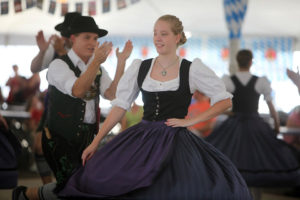 German dancing and yodeling are traditionally done. Additionally, many of the female festival-goers wear the “dirndal”, a light, circular, cut dress that is traditionally worn by rural peasant women and girls. Also, men wear the traditional “lederhosen”, the traditional German country dwelling peasant trouser outfit.
German dancing and yodeling are traditionally done. Additionally, many of the female festival-goers wear the “dirndal”, a light, circular, cut dress that is traditionally worn by rural peasant women and girls. Also, men wear the traditional “lederhosen”, the traditional German country dwelling peasant trouser outfit.
Thanksgiving
This is a uniquely North American celebration that occurs in late-November. Thanksgiving celebrates the first successful harvest that the European pilgrims had in the new colonies. It is also a time to reflect on the newly formed alliance between the European and the Native American peoples. 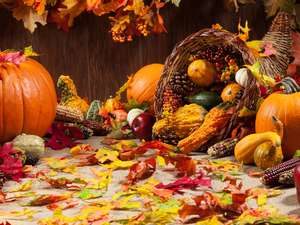 Traditionally, the meal is one that features foods that would have been harvested from the new land at this time. Apples, turkey, ham, pumpkins, squash, corn, and various other grains make up the majority of ingredients of the recipes of foods eaten on the Thanksgiving Day celebration. Additionally, meals are traditionally eaten with family and friends, as the Pilgrims and Native Americans did to celebrate their first harvest.
Traditionally, the meal is one that features foods that would have been harvested from the new land at this time. Apples, turkey, ham, pumpkins, squash, corn, and various other grains make up the majority of ingredients of the recipes of foods eaten on the Thanksgiving Day celebration. Additionally, meals are traditionally eaten with family and friends, as the Pilgrims and Native Americans did to celebrate their first harvest.
While these five festivals are unique in their own way, they all are harvest celebrations and festivals that feature feasting, both with family and public, with foods that are crops collected around the time of the festival. Two things that are central features of harvest festivals is that there is ample food and freedom from the necessity to work in the fields. Additionally, harvest celebrations also feature eating, fun, contests, and music in the local tradition of the place where they occur.
My first teaching unit this upcoming school year will be focused on harvest festivals. One goal is to give students the knowledge base of the entire plant growth cycle. So far, students have experienced cultivating seeds, witnessed sprouts germinating, plant growth and flower pollination. Each of those happened during a different season of the year (spring and summer). This unit will focus on gaining more knowledge about what happens with the harvest of fruits and vegetables during the fall season and will give students more hands-on experience about the processes and science of gardening during the fall season.
An additional goal of this unit will be to have students think critically about the changes observed in the garden as the seasons change. Students will develop academic vocabulary, and practice communicating content by comparing and contrasting the processes and patterns they observe in the garden. By adding reading selections to lessons, the unit will incorporate elements of plot development, story characteristics, and promote cultural responsiveness.
